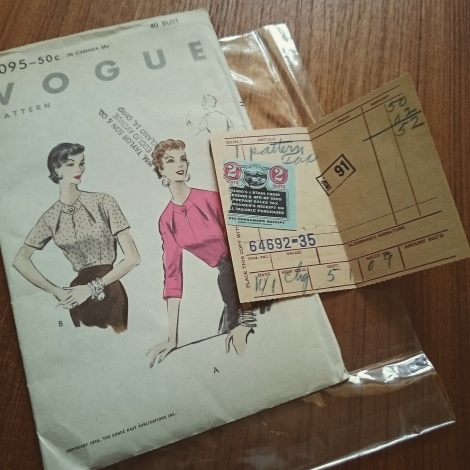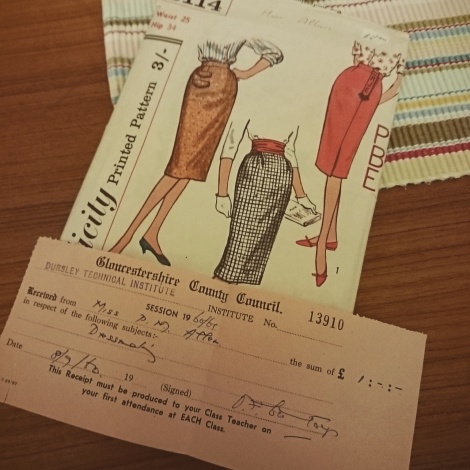I have embarked on a project of seeming epic proportions. I started trying to catalogue my vintage patterns this time last year but found the process slow going, not to mention distracting! I wanted to sew the patterns, not look at them & go through them & write about them!! So the project moved to the back burner to await a time when I’d be more motivated to faff, rather than sew. As if there really is such a time!! Fortunately for the patterns, these last two weeks have been exactly that time.
I had surgery on my right wrist two weeks ago tomorrow, effectively rendering me completely useless at any of my normal tasks. So what can you do when you can just sit around?? You upgrade your Evernote to Premium and get out the boxes of patterns! It took me two weeks to get the first box done. That’s the 30s, 40s and 50s.
I tried to start the 60s on Saturday but weekends aren’t good for concentrating on a task like this, so I’m continuing today. I have found, (rediscovered?) so many lovely patterns, many still factory folded. Thing is, they’re the ones I’d love to see made up!! Husband, being a collector too, says their value is in their current state, they should stay like that. He’s the sort who doesn’t take his stuff out of boxes… I certainly wouldn’t cut the patterns – they’d definitely be traced, but does he have a point? Should they be left in pristine, factory folded condition??
Take this one for example. It’s soooo gorgeous, I’m itching to find a suitable fabric, silk, chiffon – you get the picture, and make it up. Should I disturb the factory folds to trace it out, or does it stay “in original condition”?
Or this sexy looking Vogue pattern? That one is definitely way too good to never see the light of day as a finished, wearable garment!!
The best moments are finding previous owner’s notes, adjustments or fabric scraps in the envelopes. I’ve found a fair few rusty pins holding folds in place where the patterns needed to be shortened, as well as pencil or pen lines marking new seamlines. My favourites were finding a receipt for the original purchase of this pattern, 50c & 2c tax! It was bought in 1956 from Willian Taylor Son & Co, Ohio.
Or this pattern that came with a receipt for a dressmaking course run by the Dursley Technical Institute in 1960 in Gloucestershire.
Then there was one that was pretty interesting. I unfolded the pattern pieces for a pretty hostess apron from McCalls, 1952, to find a strip of cotton organza to make the trim edge of the apron, and a newspaper that had been cut to form a section of the apron skirt. It had no date, but an article caught my eye. Apparently it was 1971, as the article announced design house Chanel were facing their biggest backlog of orders, citing the recent death of the great lady and the fact that this collection was the last designed by her. So even in 1971 someone was using what was effectively a “retro” pattern.

Chanel Notes huge Backlog of Orders. 1971 newspaper found in 1952 McCalls apron pattern along with strip of cotton organza.
I’ve been photographing the envelopes, front and back to add to the Evernote entries. To prevent my phone getting completely clogged up, once they’ve been uploaded to Evernote, I’ve added them to a new Pinterest board and then deleted from the phone. You can see how far I’ve got on the board, My Vintage Pattern Collection. I also ordered a pack of acid free sticky topped cellophane envelopes to keep the patterns safe. Up to now I’d improvised with plastic wallets, folded over and taped down. Not really the best, but at least they accommodated all shapes and sizes of envelope! I got the cellophane envelopes from Amazon, just over £5 for 200, and free posting! Of course the free posting came courtesy of a new book and cd, but I digress. I did make rather a mess of the dining table doing all that repackaging, but it’s definitely worth it!
The Sixties is going to take me a while, there are two boxes of those!! How do you like those hat patterns sitting on top? They came in a box of all-sorts last year, factory folded and completely un-touched.
So for a while this will be my sole task, but as soon as I can sew again, I know I will have a very interesting and varied queue of patterns to sew!!








How completely fascinating! Looking at those patterns and previous-user-addons is like a trip through time.
I`m sure like any sewist I`d come down on your side of the great “use it or preserve it” divide. Surely, a pattern is made for sewing not for an archive. (On a side note, I went to philosophy lecture the other day where it was said that each and every thing(being in the world has purpose and its hightest goal should be to fulfill that purpose. Tell that to your husband when he proposes keeping patterns away from theirs! 😉 )
Oo, i like that sort of thinking!! 😃 👍
What a wonderful way to spend your recovery (which I hope is speedy, btw).
I would say it all depends on how you categorise the “value” of the patterns. Is it their intrinsic monetary value (in which case leave them folded) or their value as a route to personal satisfaction from creating a beautiful garment (in which case trace away!).
I think you know which of those I subscribe to!
Oh…and I’ve just downloaded a scanning app so at some point soon I can scan my patterns into Evernote and get them organised. My pattern collection is sadly nowhere near as lovely as yours!
I think the decision is going to be, use the patterns!! 😊 traced, of course. I started scanning the envelopes, but it was really time consuming. Photographing them with the phone means I can edit them & upload directly to Evernote. Still takes time, but way faster than using the scanner.
Oh, my. What a treasure trove you have here! All the little bits of extra in each pattern would make for a fascinating project. Enjoy reacquainting yourself with these, and I look forward to your soon-to-be project queue!
Oh, it’s going to be a long one!! 😊
You have an amazing collection! My own collection is pretty small but always growing and im trying to actually sew some of the garments now and not just hoard them in my cupboard. Patterns really deserve to be used and enjoyed!
Thank you Christina, You’d be surprised at how quickly a collection can grow when you go on ebay… 😉 I think a little tracing is in my future.
What a great way to spend a recovery. I am obviously going to be in the use them camp – but with your pattern cutting experience could you possibly just check out the pieces on the first sheet and draw your own to fit? That would perhaps save disturbing the factory folds.
That is certainly an option to consider. Then I think of the time that would take….. 😊
Yup. Tracing and then making fit would be faster.
Your collection has me drooling! And two boxes of 60s vintage patterns! Be still my heart! Feel better soon and good luck with the cataloging!
Thanks Carolyn, I’m getting there – slowly.
Awww – I hope you heal really quickly! The organisation is great – my vintage patterns are stored in acid free plastic bags in hanging files in boxes – boxes made for hanging files, that is. Each box is a decade….
Re using/preserving – hey, you are a seamstress/ collector, not just a collector, right? Did you buy patterns just for the cover art or to use them? Do you ever see yourself selling them off? think on that, and then go right ahead and get them out and trace them ;)…..
Well, I bought them for all sorts of reasons, but I really do want to see them made up, so tracing it is!
Wow! You have some amazing patterns!